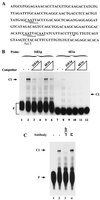Yin yang 1 negatively regulates the differentiation-specific E1 promoter of human papillomavirus type 6
- PMID: 10799595
- PMCID: PMC110873
- DOI: 10.1128/jvi.74.11.5198-5205.2000
Yin yang 1 negatively regulates the differentiation-specific E1 promoter of human papillomavirus type 6
Abstract
Human papillomavirus type 6 (HPV-6) is a low-risk HPV whose replication cycle, like that of all HPVs, is differentiation dependent. We have previously shown that CCAAT displacement protein (CDP) binds the differentiation-induced HPV-6 E1 promoter and negatively regulates its activity in undifferentiated cells (W. Ai, E. Toussaint, and A. Roman, J. Virol. 73:4220-4229, 1999). Using electrophoretic mobility shift assays (EMSAs), we now report that Yin Yang 1 (YY1), a multifunctional protein that can act as a transcriptional activator or repressor and that can also inhibit HPV replication in vitro, binds the HPV-6 E1 promoter. EMSAs, using subfragments of the promoter as competitors, showed that the YY1 binding site is located at the 5' end of the E1 promoter. When a putative YY1 site was mutated, the ability of YY1 to bind was greatly decreased. The activity of the mutated E1 promoter, monitored with the reporter gene luciferase, was threefold greater than that of the wild-type promoter, suggesting that YY1 negatively regulates HPV-6 E1 promoter activity. Nuclear extracts from differentiated keratinocytes showed decreased binding of YY1 to the wild-type promoter. Consistent with this, in differentiated keratinocytes, the activity of the transfected luciferase gene transcribed from the mutated promoter was comparable to that of the wild-type promoter; both promoters were up-regulated in differentiated keratinocytes compared to undifferentiated cells. These data suggest that YY1 functions in undifferentiated keratinocytes but not in differentiated keratinocytes. Both the wild-type and mutated promoters could be negatively regulated by overexpression of a plasmid encoding CDP. Thus, both YY1 and CDP appear to be negative regulators of the differentiation-induced HPV-6 E1 promoter and thereby the HPV life cycle. In contrast, only binding of CDP was detected using the E1 promoter of the high-risk HPV-31.
Figures









References
-
- Andres V, Chiara M D, Mahdavi V. A new bipartite DNA-binding domain: cooperative interaction between the cut repeat and homeo domain of the cut homeo proteins. Genes Dev. 1994;8:245–257. - PubMed
-
- Andres V, Nadal-Ginard B, Mahdavi V. Clox, a mammalian homeobox gene related to Drosophila cut, encodes DNA-binding regulatory proteins differentially expressed during development. Development. 1992;116:321–334. - PubMed
-
- Apt D, Watts R M, Suske G, Bernard H U. High Sp1/Sp3 ratios in epithelial cells during epithelial differentiation and cellular transformation correlate with the activation of the HPV-16 promoter. Virology. 1996;224:281–291. - PubMed
Publication types
MeSH terms
Substances
Grants and funding
LinkOut - more resources
Full Text Sources
Other Literature Sources

